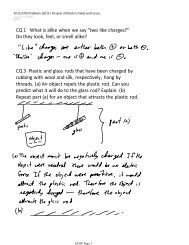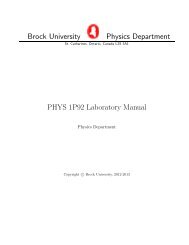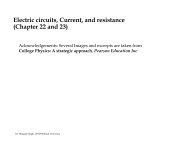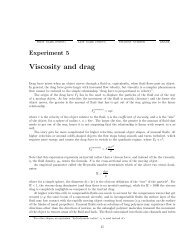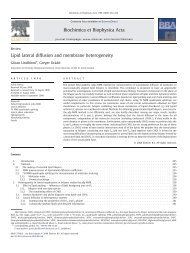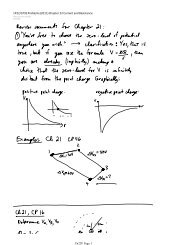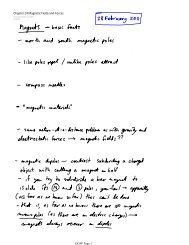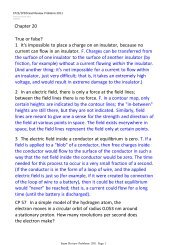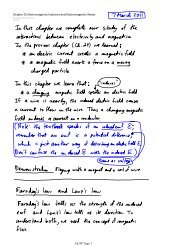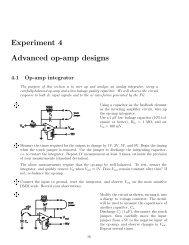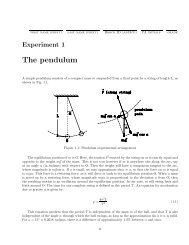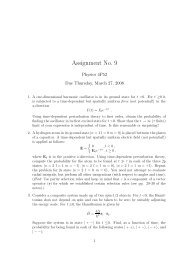Physics Department @ Brock University
Physics Department @ Brock University
Physics Department @ Brock University
You also want an ePaper? Increase the reach of your titles
YUMPU automatically turns print PDFs into web optimized ePapers that Google loves.
BROCK UNIVERSITY<br />
Page 1 of 3<br />
Final Exam: April 2010 Number of pages: 3<br />
Course: PHYS 1P22/1P92 Number of students: 121<br />
Examination date: 21 April 2010 Number of hours: 3<br />
Time of Examination: 14:00 – 17:00<br />
Instructor: S. D’Agostino<br />
A formula sheet is included with the test paper. No other aids are permitted except for a<br />
non-programmable, non-graphing calculator.<br />
Communication (during the exam) with extraterrestrial beings or entities in extradimensional<br />
hyperspaces is strictly forbidden. (Of course, such communications before the exam are<br />
permitted and, indeed, encouraged.)<br />
Solve all problems in the booklets provided.<br />
Total number of marks: 50.<br />
1. [10 marks] Clearly indicate whether each statement is TRUE or FALSE. Then provide<br />
a BRIEF explanation (i.e. one or two sentences), including a clear and complete<br />
correction of the statement if it is false. Your explanation may include formulas, if you<br />
wish. Remember, brevity and clarity are courtesy.<br />
(a) Although the total energy is conserved for all systems, the mechanical energy is<br />
not conserved for a simple harmonic oscillator, because the oscillator sometimes<br />
goes faster and sometimes goes slower.<br />
(b) A wave is called a standing wave when it is a fixed pattern that does not oscillate.<br />
(c) When car engine oil (which is black) is spilled into a puddle, the oil appears to<br />
have many different colours; this is because mixing the oil with water causes the<br />
oil to separate into its many different types of molecules.<br />
(d) For a conductor in equilibrium, the electric field inside the conductor is zero,<br />
regardless of the electric field outside the conductor.<br />
(e) An insulator cannot be charged, because current cannot pass through an insulator.<br />
(f) The electric field is constant along any equipotential surface.<br />
(g) Electricity is produced at a generating station by rotating loops of wire in a<br />
magnetic field.<br />
(h) Light bulbs in a series circuit are not necessarily equally bright; it depends on<br />
their resistances.<br />
(i) Light bulbs in a parallel circuit are equally bright, regardless of their resistances.<br />
(j) A charged particle in a magnetic field moves along a circular path.
PHYS 1P22/1P92 April 2010 Page 2 of 3<br />
2. [5 marks] A 25 pF parallel-plate capacitor with an air gap between the plates is<br />
connected to a 100 V battery.<br />
(a) Calculate the charge on the positive plate.<br />
(b) Repeat Part (a) if a Teflon slab (with a dielectric constant of 2.0) completely fills<br />
the gap between the plates.<br />
3. [5 marks] A 1.0 nC point charge is located 5 cm North of point A, and a −1.0 nC<br />
point charge is located 5 cm South of point A. Calculate the strength and direction of<br />
the electric field 5 cm East of point A.<br />
4. [5 marks] The electric field strength is 20,000 V/m inside a parallel-plate capacitor<br />
for which the distance between the plates is 1.0 mm. An electron is released from rest<br />
at the negative plate. Calculate the electron’s speed when it reaches the positive plate.<br />
5. [5 marks] Consider the circuit in the diagram.<br />
23_FigureP59.pdf<br />
(a) Calculate the current flowing through the 2.0 Ω resistor.<br />
(b) Calculate the power dissipated by the 20 Ω resistor.<br />
(c) Calculate the cost to run the circuit for 30 days if electricity costs 10 cents per<br />
kWh.<br />
6. [5 marks] A thin film of MgF 2 , which has an index of refraction of 1.38, coats a piece<br />
of glass, which has an index of refraction of 1.50. Calculate the thinnest film that<br />
results in destructive interference for the reflection of light of wavelength 500 nm.<br />
7. [5 marks] A mass spectrometer has a constant magnetic field of 0.050 T. Particles of<br />
charge +e are injected into the spectrometer with a speed of 2.5 ×10 5 m/s.<br />
(a) Calculate the mass of the particles if each of them moves along a circular path of<br />
radius 0.21 m.<br />
(b) Calculate the strength of the electric field that must be introduced (while the magnetic<br />
field remains the same) so that the particles injected into the spectrometer<br />
will travel along a straight path.
PHYS 1P22/1P92 April 2010 Page 3 of 3<br />
8. [5 marks] The circuit shown in the figure encloses an area of 25 cm 2 . The magnetic<br />
field (indicated by the dots) increases steadily from 0 T to 0.50 T in 10 ms. Calculate<br />
the current in the resistor during this time.<br />
25_FigureP18.pdf<br />
9. [5 marks] Two 50 g blocks are held 30 cm above a table, as shown in the figure. One<br />
of them is just barely touching the top of a spring that is 30 cm long. The blocks are<br />
released at the same time. The block on the left hits the table at exactly the same<br />
time as the block on the right reaches the lowest point of its motion. Calculate the<br />
value of the spring’s stiffness constant.<br />
14_FigureP57.pdf
Potentially useful data and formulas<br />
F = K |q 1| |q 2 |<br />
r 2<br />
U elec = qV<br />
⃗ E =<br />
⃗ F<br />
q<br />
E = ∆V<br />
d<br />
Q = C∆V parallel-plate capacitor: E = Q<br />
ɛ 0 A<br />
C = κɛ 0A<br />
d<br />
point charge: E = K |q|<br />
r 2<br />
point charge: V = K q r<br />
E ′ = E κ<br />
and<br />
U C = 1 2 · Q2<br />
C = 1 2 C(∆V )2 u E = U C<br />
volume = 1 2 κɛ 0E 2<br />
C = ɛ 0A<br />
d<br />
R = ρL A<br />
I = ∆Q<br />
∆t<br />
∆V = IR<br />
P = ∆U<br />
∆t = I∆V = I2 R =<br />
(∆V )2<br />
R<br />
Kirchhoff:<br />
∑<br />
Iin = ∑ I out<br />
∆V loop = ∑ i<br />
∆V i = 0<br />
R eq = R 1 + R 2 + R 3 + · · · + R N R eq =<br />
( 1<br />
R 1<br />
+ 1 R 2<br />
+ 1 R 3<br />
+ · · · + 1<br />
R N<br />
) −1<br />
B = µ 0I<br />
2πr<br />
B = µ 0NI<br />
2R<br />
B = µ 0 I N L<br />
(long wire)<br />
(centre of loop with N turns)<br />
(inside a solenoid)<br />
⃗F = q⃗v × ⃗ B which is equivalent to F = qvB sin θ<br />
F = ILB F = µ 0LI 1 I 2<br />
2πd<br />
Φ = AB cos θ<br />
E = N<br />
∆Φ<br />
∣ ∆t ∣
kinetic energy = 1 2 mv2<br />
gravitational potential energy = mgh<br />
centripetal force = mv2<br />
r<br />
F = −kx x = A cos(2πft) v = −(2πf)A sin(2πft) a = −(2πf) 2 A cos(2πft)<br />
U = 1 2 kx2<br />
f = 1 T<br />
f = 1<br />
2π<br />
√<br />
k<br />
m<br />
v = fλ<br />
n = c v<br />
double-slit (bright):<br />
θ m = m λ d<br />
and<br />
y m = m λL d<br />
(dark): y m =<br />
(<br />
m + 1 ) λL<br />
2 d<br />
diffraction grating (bright): d sin θ m = mλ and y m = L tan θ m<br />
thin films:<br />
2t = m λ n<br />
and 2t =<br />
(<br />
m + 1 ) λ<br />
2 n<br />
K = 8.99 × 10 9 N · m2<br />
C 2<br />
ɛ 0 = 8.85 × 10 −12 C 2<br />
N · m 2<br />
µ 0 = 1.26 × 10 −6 T · m<br />
A<br />
−11 N · m2<br />
G = 6.67 × 10<br />
kg 2<br />
g = 9.80 m/s 2<br />
mass of proton (and neutron) = 1.67 × 10 −27 kg<br />
mass of electron = 9.11 × 10 −31 kg<br />
fundamental unit of charge: e = 1.60 × 10 −19 C<br />
speed of light in vacuum: c = 3.00 × 10 8 m/s
Solutions<br />
1.(a) F. The speed changes because energy is continuously converted from kinetic to<br />
potential and back again.<br />
(b) F. A standing wave is a wave confined between barriers. The reflections of the wave<br />
from the barriers interfere to create the pattern of nodes and oscillating anti-nodes.<br />
(c) F. The oil spreads out over the water in a thin film; however, the thickness of the film<br />
varies. Light incident on the film is reflected if it has the right wavelength, which depends on<br />
the thickness of the film. Thus, regions of the film with different thicknesses reflect different<br />
wavelengths of light, which means that different regions of the film appear to be a different<br />
colour.<br />
(d) T. Because conductors have many ”free” electrons, the free electrons in a conductor<br />
will move in response to the applied electric field. In an extremely short time, some free<br />
electrons will arrange themselves on the surface of the conductor so that the net electric<br />
field inside the conductor (the superposition of the applied field and the field due to the<br />
rearranged charges in the conductor) is zero.<br />
(e) F. For example, rubbing your feet on a carpet on a dry winter day transfers charge<br />
between you and the carpet (the latter is an insulator). Although charges cannot easily pass<br />
through an insulator, charge can be transferred onto the surface of an insulator.<br />
(f) F. The electric potential is constant along an equipotential surface. The magnitude<br />
of the electric field depends on the rate of change of the electric potential, and so can be<br />
different at different points along an equipotential surface.<br />
(g) T. The idea behind this is called Faraday’s law of induction. The voltage induced in<br />
the loop of wire (and therefore the current, as well) depends on the orientation and size of<br />
the loop, the number of turns of wire, the strength of the magnetic field, and the rate at<br />
which the loop turns.<br />
(h) T. The current through each element of the series circuit is the same, but the brightness<br />
of each bulb depends on the power dissipated, which is I 2 R. Therefore the brightness<br />
of each bulb depends on its resistance.<br />
(i) F. The voltage across each branch of a parallel circuit is the same, but the brightness<br />
of each bulb depends on the power dissipated, which is V 2 /R, and therefore depends on the<br />
resistance of each bulb.<br />
(j) F. It depends on the initial direction of the charged particle, and it also depends on<br />
whether the magnetic field is constant or not. Under certain circumstances the path can be<br />
circular, but it also might be a straight line, a spiral, or a more complicated path.<br />
2.(a) Q = CV = 25 pF × 100 V = 2500 pC = 2.5 nC<br />
(b) The capacitance of the capacitor is now 2.0 × 25 pF = 50 pF, so the charge on each<br />
plate is now Q = CV = 50 pF × 100 V = 5000 pC = 5.0 nC<br />
3. 2545 V/m South<br />
4. The electron “falls” through a potential difference of 20, 000 × 0.001 = 20 V. Thus,<br />
the electron loses potential energy of e∆V = 1.6 × 10 −19 × 20 = 3.2 × 10 −18 J. The increase
in the electron’s kinetic energy is equal to its loss of potential energy, so:<br />
1<br />
2 mv2 − 1 2 mv2 0 = 3.2 × 10 −18<br />
1<br />
2 mv2 − 1 2 m(0)2 = 3.2 × 10 −18<br />
mv 2 = 6.4 × 10 −18<br />
v 2 6.4 × 10−18<br />
=<br />
√<br />
9.11 × 10 −31<br />
6.4 × 10 −18<br />
v =<br />
9.11 × 10 −31<br />
= 2.651 × 10 6<br />
Thus, the final speed of the electron is 2.7 × 10 6 m/s.<br />
5. (a) The resistance R of the parallel part of the circuit satisfies<br />
1<br />
R = 1 20 + 1 5<br />
= 1 20 + 4 20<br />
= 5 20<br />
= 1 4<br />
R = 4 Ω<br />
Thus, the total resistance of the circuit is 2 + 4 + 4 = 10 Ω. The current flowing from<br />
the “battery,” all of which passes through the 2-Ω resistor, is therefore<br />
I = V R<br />
= 100<br />
10<br />
= 10 A<br />
(b) The total current that flows in the parallel part of the circuit is I = 10 A. Let I 1<br />
represent the current flowing through the 20-Ω resistor, and let I 2 represent the current<br />
flowing through the 5-Ω resistor. Then<br />
I 1 + I 2 = 10 A<br />
I 2 = 10 − I 1<br />
Also, because the voltage drop across each branch of the parallel part of the circuit is
the same,<br />
I 1 R 1 = I 2 R 2<br />
20I 1 = 5I 2<br />
20I 1 = 5 (10 − I 1 )<br />
20I 1 = 50 − 5I 1<br />
25I 1 = 50<br />
I 1 = 2 A<br />
The power dissipated by the 20-Ω resistor is therefore<br />
P = I 2 1R 1<br />
= 2 2 × 20<br />
= 80 W<br />
(c) From Part (a), the total resistance of the circuit is 10 Ω and the total current leaving<br />
the “battery” is 10 A. Therefore, the total power dissipated by the circuit is P = I 2 R =<br />
10 2 × 10 = 1000 W.<br />
The total energy E dissipated by the circuit in 30 days is<br />
E = P · t<br />
= 1000 W · 30 days<br />
= 1 kW · 30 × 24 hours<br />
= 720 kWh<br />
Therefore, the total cost to run the circuit for 30 days is 0.1 × 720 = $72.<br />
6. For destructive interference with this configuration of indices of refraction, the thickness<br />
t of the film satisfies<br />
(<br />
2t = m + 1 ) λ<br />
2 n<br />
The thinnest film has the minimum value of m+1/2; that is, m = 0. Therefore, the thickness<br />
of the thinnest film is<br />
t = λ<br />
4n<br />
= 500<br />
(4)(1.38)<br />
= 90.6 nm<br />
7. (a) Because each particle moves in a circle of radius r, the acceleration (centripetal) of<br />
each particle is v 2 /r. Because the path of each particle is circular, the particles are injected<br />
perpendicular to the direction of the magnetic field. Therefore, the magnitude of the force
acting on each particle is qvB. By Newton’s second law of motion,<br />
F = ma<br />
qvB = mv2<br />
r<br />
m = qvBr<br />
v 2<br />
= qBr<br />
v<br />
= 1.6 × 10−19 (0.05)(0.21)<br />
2.5 × 10 5<br />
= 6.7 × 10 −27 kg<br />
(b) In this situation, if each particle is to move in a straight line, then the net force on<br />
each must be zero. This means that the magnitude of the electric force must be the same<br />
as the magnitude of the magnetic force (their directions are opposite, but we don’t have to<br />
worry about that in the following calculation). Thus,<br />
qE = qvB<br />
E = vB<br />
= ( 2.5 × 10 5) (0.05)<br />
= 12, 500 V/m<br />
8. By Faraday’s law of induction, the emf induced in the circuit by the changing magnetic<br />
field is<br />
E = ∆Φ<br />
∆t = BA<br />
∆t<br />
= (0.5)(0.0025)<br />
0.01<br />
= 0.125 V<br />
By Lenz’s law, the direction of the induced emf is the same as the emf induced by the battery.<br />
Thus, the net emf in the circuit is 9+0.125 = 9.125 V. The current in the resistor is therefore<br />
I = V R<br />
= 9.125<br />
20<br />
= 0.456 A<br />
9. The time t needed for the block on the left to hit the table satisfies<br />
∆y = 1 2 gt2<br />
t 2 = 2∆y<br />
g<br />
= (2)(0.3)<br />
9.8<br />
= 0.06122<br />
t = 0.2474 s
This time represents half a cycle for the block on the right; thus, the period of the block<br />
on the right is<br />
T = 2(0.2474) = 0.495 s<br />
Because the angular frequency of oscillation ω satisfies ω 2 = k/m, the spring’s stiffness<br />
constant is<br />
k = mω 2<br />
= 4π2 m<br />
T 2<br />
= 4π2 (0.05)<br />
0.495 2<br />
= 8.1 N/m



